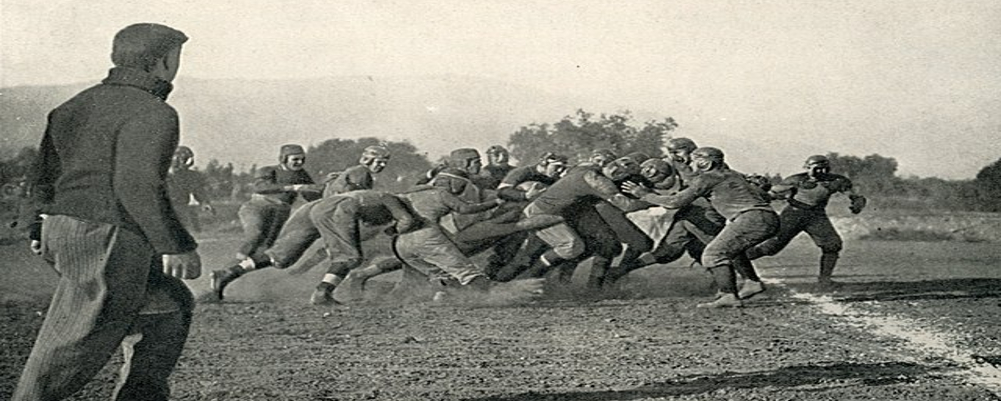One thing they all do is keep the score of the contest but it is interesting to know the story of the verbiage on these information centers.
The story of how the word "Visitors" and or "guests" first appeared on scoreboards from FootballArchaeology.com.
Transcribed Conversation with Timothy Brown on Opponents Visitor Scoreboard
Hello, my football friends; this is Darin Hayes of PigskinDispatch.com. Welcome once again to The Pig Pen, your portal to positive football history, and welcome to another Tuesday where we get to welcome in our guest, Timothy Brown of FootballArcheology.com. Tim, welcome back to The Pig Pen.
Hey, Darin, thank you. Always good to be here chatting with you about old football stuff.
Yes, old football stuff, and we're definitely going to be talking about that today. And since you are a guest here on Pigskin Dispatch, I guess you're my visitor, not my opponent. So I think that'll maybe lead to some of the topics you're going to talk about today from one of your recent tidbits.
Yeah, so that is a beautiful segue. Not very imaginative. Yes, yes.
Yeah, so I just think this one is really fun. I mean, part of what I like about football is the evolution of words and terminology. And my most recent book was basically about that topic.
And so this is one, it got started with, I had come across a story probably three or four years ago about Harvard. There was a professor at Harvard who, when they built Harvard Stadium and they put up the scoreboard, it said Harvard and then opponent. And he just didn't like the term opponent.
He just felt like these are our guests. And so he wanted them to change the terminology. And he was like, by then, he was a Dean.
So kind of what he said happened. And so they changed the terminology to guest or visitor. So even now, I went out and searched a bunch of different, scoreboard manufacturers, and there, unless it's a digital one where they can put in whatever name of the visiting team is, the typical scoreboard will be like home and away, or it's the home team's name and then visitor or guest.
And so opponent just isn't there anymore. So this guy, and this is back in 1905 or something like that, that he finally got the thing changed, but he is this one guy's opinion. And basically it's kind of proliferated throughout football and probably all kinds of other.
I think all sports because I could, I can remember when I was a kid in grade school, we had an old scoreboard, the old dial clock type, our scoreboard and had, but it had, I'm pretty sure it had a home, and it had guests on it. I guess I never really thought about it, you know, cause now today you always see, you know, visitors or away is probably the common thing, but, but those are, those are actually kind of polite and welcoming things, I guess, I guess the opponents or, you know, the, you know, the idiots from across town or whatever else you're going to put on there. And those were the days when, oftentimes after the game, the two teams would sit down and have dinner together. You know, so, you know, they were supposed to be treated as guests. And so, yeah, it's just, you know, it was kind of a different time.
And especially like in the Ivies, it was more of a gentleman's sort of thing than perhaps even it is there today, but yeah. So, you know, it takes us back to a bygone era. Right.
But the other thing about that then was, you know, so I'd had this story sitting in my head for four years, and then it was like, well, this isn't enough to do a tidbit. I mean, you know, I've got connected to something else. And so then I came across the story of Lehigh and Lafayette, who are, you know, bitter rivals.
And in the 1959 game, then, it was at Lehigh. Both teams were four and four coming in though Lehigh was favored. However, as the game progressed, Lehigh did not treat Lafayette as a guest.
They treated them as something beneath an opponent. And, you know, because Lehigh was unexpectedly losing them, some of their fans, you know, apparently got ahold of pears and apples and had them in their pockets or whatever. They're out there in a very cold, you know, last game of the season, cold weather.
And they started flinging them up into the Lafayette stands. Later on, lettuce and cabbages and apparently a few bottles went Lafayette's way as well. And as that was happening, Lehigh was falling further and further behind on the field.
And so then the last thing was that you know, Lehigh ends up, or Lafayette wins the game 28 to six, and they end up, the Lehigh fans went out onto the field to protect the goalposts so that Lafayette could not tear them down. Because, you know, back then, fans toured on the goalposts all the time, you know, they were wooden. They weren't as secured into the ground as they are now.
Plus, you know, enough teams hadn't been sued yet for people being injured by falling goalposts. So the home team didn't protect them as well as they do nowadays. But anyway, you know, so that was kind of a riot, and a bunch of fights ensued.
And, you know, so there was a time where there were tensions between the Lehigh and Lafayette fans. But one of the cool things about that story then was that a day or two after I published it, I got an email from a guy who played in the game. And so he and I are, you know, we'll be connecting and chatting in the near term, but he sent me some information.
And I did another. One of the tidbits of late was about the era of using rubber footballs. There was talk about rubber footballs replacing the leather. And so this guy, Mike, became a Big East official.
And so, you know, he ended up part of the story that I tell. And that is one of the stories that he sent me, you know, in a document that he had produced. So anyway, we're going to get together and chat a little bit.
But it's one of the fun things about reading these things is, you know, I, oftentimes I hear from the children or the grandchildren of people, you know, that I write about, but in this case, it's, you know, somebody who's out there playing on the field that day, so, which is pretty cool. Yeah.
Very cool. Now, isn't Lehigh and Lafayette the longest? They played the most times of any two opponents in college football history. Is that my thinking? Right. Okay.
Yeah. They played most often back in the 1890s; they played twice a year. So that's part of why they went ahead of everybody else.
But, otherwise, I think they've, I think they've played every, every year, but you know, perhaps there was a gap somewhere. Yeah. Yeah.
Very interesting. Great story. And it's great that you're getting some great feedback from folks like that, too, especially somebody who played in the game.
That's, that's really cool. So yeah, very, very nicely done. Well-researched, just like everything that you do is, and you have such interesting things that come out each and every night in your tidbits, Tim.
And, you know, folks, I'm sure, well, we know they appreciate you're, you're getting some responses back, and maybe if you could share with the listeners here, how they too can partake in reading some of your tidbits, that'd be a great thing. Yeah. So, you know, the best thing or the easiest thing is to just go to my site, footballarchaeology.com, and just subscribe.
And then, every night, you'll get an email at seven Eastern, and it shows up in your inbox. And then, you know, you know, I have some people clearly, you know, the best majority of people read it that night, or at least they open it that night, decide if they want to read it or not. But, you know, there are others, they let them pile up to the weekend and then, you know, you know, they'll go through them because I can just, you know, the number of hits that I get or email opens, you know, I can tell, you know, that the system tracks that for me.
So anyway, that's the best thing. I post on threads now, I post on the Substack app, and I'm still posting on Twitter. It has now been named X, so we'll see how long that lasts.
All right, Tim. Thank you very much, and we will talk to you again next Tuesday.
Very good. Thank you.
Transcribed by TurboScribe.ai.
A walk into any American football stadium reveals a familiar sight: towering scoreboards displaying team names, scores, and the enigmatic word "VISITORS" beside one of them. But have you ever wondered how this seemingly mundane term became an ingrained part of the gridiron lexicon? Surprisingly, its origins hold a fascinating window into the evolution of American football and the shifting dynamics of competition.
Here the story is told best Visitors on the Scoreboard Football Archaeology Tidbit.



